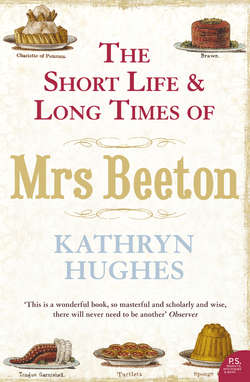Читать книгу The Short Life and Long Times of Mrs Beeton - Kathryn Hughes - Страница 8
INTERLUDE
Оглавление‘The Free, Fair Homes of England’
Caption to the Frontispiece of the Book of Household Management
YOU DO NOT have to get very far into the Book of Household Management (BOHM) to realize that one of its main preoccupations is the loss of Eden. The Frontispiece is an exquisitely coloured plate that shows an extended family group from the early nineteenth century, clustered around the door of a tiled cottage at harvest time. The men are plump John Bulls, prosperous in gaiters. The principal female figure is serving them beer which, judging from the golden haze in the middle distance, she has brewed from her own grain. In the foreground ducks dabble, hens peck and cows drowse under a tree, while a bulldog keeps a beady watch on the men gathering hay on the horizon. The caption underneath explains that this scene represents ‘The Free, Fair Homes of England’, a line from the Romantic poet Felicia Hemans. In other words, here is a time before industrialization scarred the land, cut a generation of town dwellers from its gentle rhythms, and replaced convivial kin groups with edgy strangers.
You just know that Mrs Beeton would love to step into that picture. The Book of Household Management is saturated with a longing for an agrarian world that has already slipped into extinction but just might, by some enormous effort of will, be brought back into play. So, in her instructions for making a syllabub Mrs Beeton suggests mixing up some sugar and nutmeg and then simply squirting the milk from the cow’s udder straight into the bowl. (For those unlucky readers who do not have their own cow immediately to hand Beeton suggests substituting a milk-filled jug poured from a great height to produce the required froth.)
Throughout the BOHM animals destined for the table are described in their natural habitat with such lulling, lyrical grace that you seem to find yourself watching them from the corner of a hot, summer meadow. Here, for instance, is Beeton describing the eating habits of a sheep: ‘indolently and luxuriously [the sheep] chews his cud with closed eyes and blissful satisfaction, only rising when his delicious repast is ended to proceed silently and without emotion to repeat the pleasing process of laying in more provender, and then returning to his dreamy siesta to renew the delightful task of rumination’. Elsewhere Beeton’s text is scattered with drawings that reinforce the unforced bounty of nature. Pigs snuffle in well-kept sties (no nasty urban courtyard here), a landrail hares through the undergrowth, while deer bound through what looks like heather with the Scottish Highlands peaking in the background. The illustration heading up the chapter on vegetables is a cornucopia of cabbage, onions, and leeks, seeming for all the world like something that has just been plucked from the soil in time for the Harvest Festival supper.
Such soft-focus rural fantasy was only possible because Mrs Beeton, like most of her readers, was actually a sharp-edged daughter of the industrial age. Her guidelines for domestic bliss have less to do with the farmhouse than the factory. Briskly she divides the working day into segments and allots each household member from the mistress to the scullery maid a precise set of tasks that read like a time and motion study. (There is no point housemaids starting work until 7 a.m. in the winter, for instance, since rising any earlier will be a waste of candle.) The labour is specialized, repetitive, and, more often than not, mechanized. Kitchen equipment is described and illustrated as if it were industrial plant; the laundry maid’s duties make her sound like the head boilerman on a steamship.
So, too, for all that Mrs Beeton gestures dewy-eyed to the days of ‘auld lang syne’ when households produced their own butter, eggs, bread, and wine, she spends much of her time urging short cuts on her readers. Commercially bottled sauces and pickles get a cautious welcome (they’re probably not as good as home-made, she admits, but at least they don’t cost any more). And when it comes to baking Beeton is ambivalent about whether you should even bother to do it yourself. The illustration to ‘General Observations on Bread, Biscuits and Cakes’ may show an artful pyramid of rustic-looking loaves, with a windmill grinding in the background, yet a few pages later Mrs Beeton dedicates several enthusiastic paragraphs to a newly patented system for mass-producing aerated bread. During this process ‘the dough is mixed in a great iron ball, inside which is a system of paddles … then the common atmospheric air is pumped out, and the pure gas turned on.’ It was from these unappetizing beginnings that the Aerated Bread Company or ABC would emerge to become a commercial giant of the nineteenth and twentieth centuries, providing white sliced loaf, as smooth and tasteless as sponge, to the nation.
None of this makes Mrs Beeton’s rusticism phoney, although her vision of agrarian Britain is quaintly out of date, lacking any mention of intensive farming methods, high seasonal unemployment, and endemic poverty among the rural working class. But what Beeton shared with some of the most persuasive voices of her age was the nagging feeling that all the good things about modern urban living – heat on demand, sauces that came out the same every time, a dripping pan furnished with its own stand – arrived at a cost. But what that cost was exactly, and whether it was too high a price to pay for convenience, safety, and comfort was something that she hardly had time to consider. Whirling not so much like a dervish as a cog in a particularly intricate machine, she pressed on in a blur of activity, determined to finish her 1,112 pages in record time. ‘The Free, Fair Homes of England’ remained a lovely, compensating dream.
